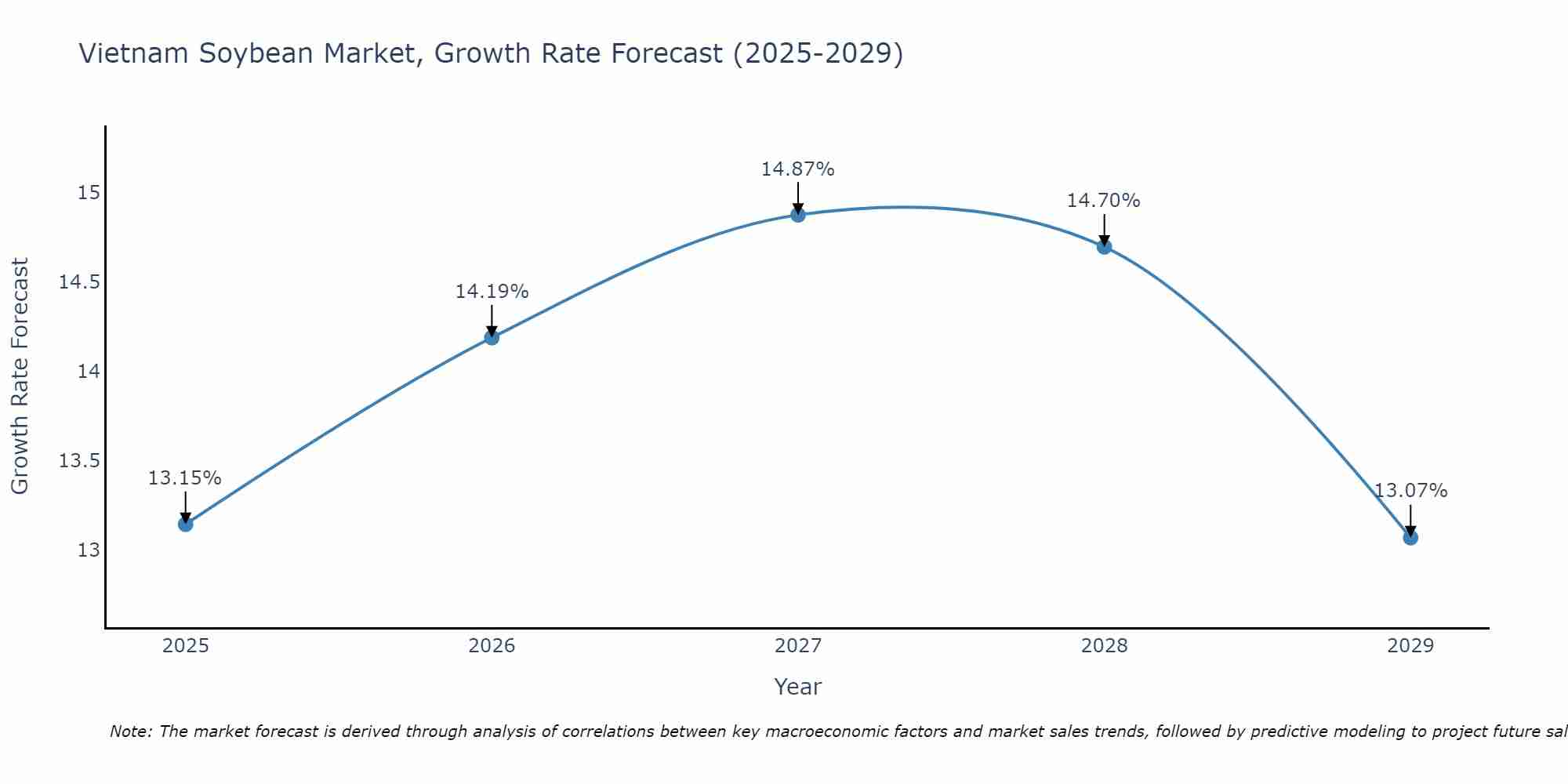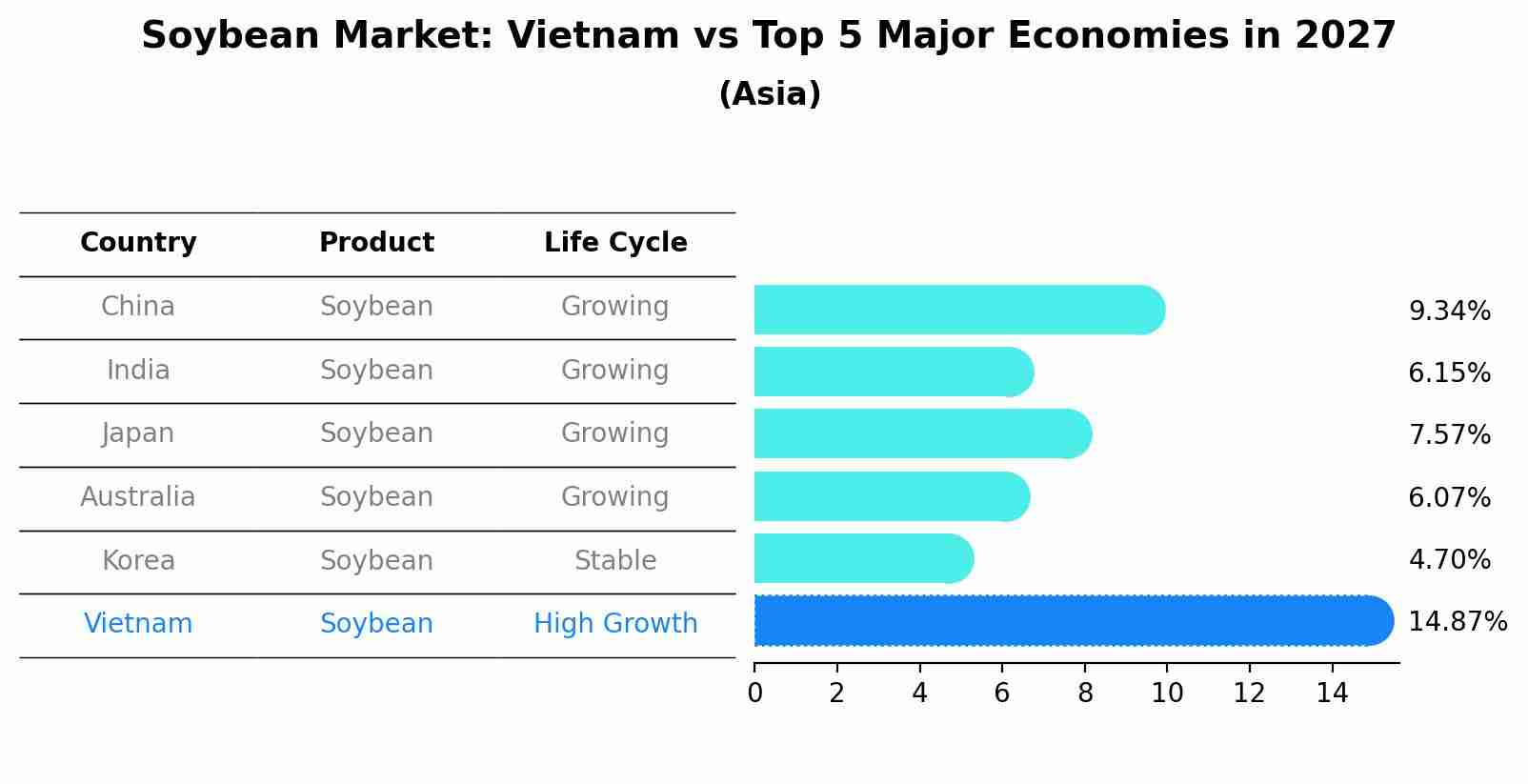Vietnam Soybean Market (2025-2031) Outlook | Trends, Value, Forecast, Revenue, Companies, Share, Analysis, Industry, Growth & Size
| Product Code: ETC224670 | Publication Date: Aug 2022 | Updated Date: Aug 2025 | Product Type: Market Research Report | |
| Publisher: 6Wresearch | Author: Ravi Bhandari | No. of Pages: 75 | No. of Figures: 35 | No. of Tables: 20 |
Vietnam Soybean Market Size Growth Rate
The Vietnam Soybean Market is projected to witness mixed growth rate patterns during 2025 to 2029. Growth accelerates to 14.87% in 2027, following an initial rate of 13.15%, before easing to 13.07% at the end of the period.

Soybean Market: Vietnam vs Top 5 Major Economies in 2027 (Asia)
Vietnam's Soybean market is anticipated to experience a high growth rate of 14.87% by 2027, reflecting trends observed in the largest economy China, followed by India, Japan, Australia and South Korea.

Vietnam Soybean Market Synopsis
The soybean market in Vietnam plays a pivotal role in the country`s agriculture and food production. Soybeans are a valuable source of protein and are used to produce various soy-based products, including tofu, soy sauce, and soybean oil. With the growing popularity of plant-based diets and the versatile use of soybeans in Vietnamese cuisine, the market remains a significant contributor to the food industry.
Drivers of the Market
The growth of the Vietnam soybean market is driven by consumers` awareness of soybean`s nutritional value, the culinary use of soybeans in traditional dishes and plant-based recipes, and their applications in soy milk and tofu production. Soybeans offer a nutty and creamy taste. The market benefits from consumers` focus on plant-based protein sources, the inclusion of soybeans in Asian and international cuisines, and their role as a protein-rich and sustainable legume. Manufacturers offer soybean products that cater to consumers` dietary and culinary preferences, contributing to the market`s expansion.
Challenges of the Market
In the Vietnam soybean market, challenges arise from supply chain sustainability and competition from alternative protein sources. Soybeans are a valuable source of protein, but ensuring a sustainable supply chain while addressing concerns related to deforestation and land use is essential. Additionally, competition from alternative protein sources like tofu and tempeh requires effective marketing strategies to maintain or expand market share.
COVID-19 Impact on the Market
The Vietnam soybean market faced challenges during the COVID-19 pandemic, primarily related to supply chain disruptions. Soybeans, a crucial ingredient for various food products and animal feed, experienced fluctuations in availability due to disruptions in international trade and logistics. These disruptions impacted both imports of soybeans and the export of soy-based products. Manufacturers and farmers adapted by exploring domestic soybean cultivation options. Despite the challenges, soybeans remained an essential component of the food and agriculture sector in Vietnam, with the market displaying resilience amid changing global conditions.
Key Players in the Market
Key players in the Vietnam soybean market include both domestic soybean growers and international suppliers of soybean products. Domestic companies like Cong Ty CP Sach Phong Thuy and Tan Do Beverage Joint Stock Company play a significant role in soybean cultivation and distribution within Vietnam. Additionally, international suppliers of soybean products like Cargill, Incorporated and Bunge Limited are influential players in providing high-quality soybeans to the Vietnamese market, supporting various food processing and manufacturing sectors.
Key Highlights of the Report:
- Vietnam Soybean Market Outlook
- Market Size of Vietnam Soybean Market, 2024
- Forecast of Vietnam Soybean Market, 2031
- Historical Data and Forecast of Vietnam Soybean Revenues & Volume for the Period 2021-2031
- Vietnam Soybean Market Trend Evolution
- Vietnam Soybean Market Drivers and Challenges
- Vietnam Soybean Price Trends
- Vietnam Soybean Porter's Five Forces
- Vietnam Soybean Industry Life Cycle
- Historical Data and Forecast of Vietnam Soybean Market Revenues & Volume By Applications for the Period 2021-2031
- Historical Data and Forecast of Vietnam Soybean Market Revenues & Volume By Crush for the Period 2021-2031
- Historical Data and Forecast of Vietnam Soybean Market Revenues & Volume By Feed Use for the Period 2021-2031
- Historical Data and Forecast of Vietnam Soybean Market Revenues & Volume By Food Use for the Period 2021-2031
- Vietnam Soybean Import Export Trade Statistics
- Market Opportunity Assessment By Applications
- Vietnam Soybean Top Companies Market Share
- Vietnam Soybean Competitive Benchmarking By Technical and Operational Parameters
- Vietnam Soybean Company Profiles
- Vietnam Soybean Key Strategic Recommendations
Frequently Asked Questions About the Market Study (FAQs):
1 Executive Summary |
2 Introduction |
2.1 Key Highlights of the Report |
2.2 Report Description |
2.3 Market Scope & Segmentation |
2.4 Research Methodology |
2.5 Assumptions |
3 Vietnam Soybean Market Overview |
3.1 Vietnam Country Macro Economic Indicators |
3.2 Vietnam Soybean Market Revenues & Volume, 2021 & 2031F |
3.3 Vietnam Soybean Market - Industry Life Cycle |
3.4 Vietnam Soybean Market - Porter's Five Forces |
3.5 Vietnam Soybean Market Revenues & Volume Share, By Applications, 2021 & 2031F |
4 Vietnam Soybean Market Dynamics |
4.1 Impact Analysis |
4.2 Market Drivers |
4.2.1 Increasing consumer awareness about the health benefits of soybeans |
4.2.2 Growing demand for plant-based protein sources in Vietnam |
4.2.3 Government initiatives to promote soybean cultivation and processing in the country |
4.3 Market Restraints |
4.3.1 Dependence on imports for soybean supply |
4.3.2 Fluctuating global soybean prices affecting local market stability |
4.3.3 Limited technological advancements in soybean farming and processing in Vietnam |
5 Vietnam Soybean Market Trends |
6 Vietnam Soybean Market, By Types |
6.1 Vietnam Soybean Market, By Applications |
6.1.1 Overview and Analysis |
6.1.2 Vietnam Soybean Market Revenues & Volume, By Applications, 2021-2031F |
6.1.3 Vietnam Soybean Market Revenues & Volume, By Crush, 2021-2031F |
6.1.4 Vietnam Soybean Market Revenues & Volume, By Feed Use, 2021-2031F |
6.1.5 Vietnam Soybean Market Revenues & Volume, By Food Use, 2021-2031F |
7 Vietnam Soybean Market Import-Export Trade Statistics |
7.1 Vietnam Soybean Market Export to Major Countries |
7.2 Vietnam Soybean Market Imports from Major Countries |
8 Vietnam Soybean Market Key Performance Indicators |
8.1 Percentage increase in domestic soybean production |
8.2 Adoption rate of soy-based products in the Vietnamese market |
8.3 Investment in research and development for soybean cultivation techniques |
9 Vietnam Soybean Market - Opportunity Assessment |
9.1 Vietnam Soybean Market Opportunity Assessment, By Applications, 2021 & 2031F |
10 Vietnam Soybean Market - Competitive Landscape |
10.1 Vietnam Soybean Market Revenue Share, By Companies, 2024 |
10.2 Vietnam Soybean Market Competitive Benchmarking, By Operating and Technical Parameters |
11 Company Profiles |
12 Recommendations |
13 Disclaimer |
- Single User License$ 1,995
- Department License$ 2,400
- Site License$ 3,120
- Global License$ 3,795
Search
Thought Leadership and Analyst Meet
Our Clients
Related Reports
- Afghanistan Apparel Market (2026-2032) | Growth, Outlook, Industry, Segmentation, Forecast, Size, Companies, Trends, Value, Share, Analysis & Revenue
- Canada Oil and Gas Market (2026-2032) | Share, Segmentation, Value, Industry, Trends, Forecast, Analysis, Size & Revenue, Growth, Competitive Landscape, Outlook, Companies
- Germany Breakfast Food Market (2026-2032) | Industry, Share, Growth, Size, Companies, Value, Analysis, Revenue, Trends, Forecast & Outlook
- Australia Briquette Market (2025-2031) | Growth, Size, Revenue, Forecast, Analysis, Trends, Value, Share, Industry & Companies
- Vietnam System Integrator Market (2025-2031) | Size, Companies, Analysis, Industry, Value, Forecast, Growth, Trends, Revenue & Share
- ASEAN and Thailand Brain Health Supplements Market (2025-2031) | Strategy, Consumer Insights, Analysis, Investment Trends, Opportunities, Growth, Size, Share, Industry, Revenue, Segments, Value, Segmentation, Supply, Forecast, Restraints, Outlook, Competition, Drivers, Trends, Demand, Pricing Analysis, Competitive, Strategic Insights, Companies, Challenges
- ASEAN Bearings Market (2025-2031) | Strategy, Consumer Insights, Analysis, Investment Trends, Opportunities, Growth, Size, Share, Industry, Revenue, Segments, Value, Segmentation, Supply, Forecast, Restraints, Outlook, Competition, Drivers, Trends, Demand, Pricing Analysis, Competitive, Strategic Insights, Companies, Challenges
- Europe Flooring Market (2025-2031) | Outlook, Share, Industry, Trends, Forecast, Companies, Revenue, Size, Analysis, Growth & Value
- Saudi Arabia Manlift Market (2025-2031) | Outlook, Size, Growth, Trends, Companies, Industry, Revenue, Value, Share, Forecast & Analysis
- Uganda Excavator, Crane, and Wheel Loaders Market (2025-2031) | Strategy, Consumer Insights, Analysis, Investment Trends, Opportunities, Growth, Size, Share, Industry, Revenue, Segments, Value, Segmentation, Supply, Forecast, Restraints, Outlook, Competition, Drivers, Trends, Demand, Pricing Analysis, Competitive, Strategic Insights, Companies, Challenges
Industry Events and Analyst Meet
Whitepaper
- Middle East & Africa Commercial Security Market Click here to view more.
- Middle East & Africa Fire Safety Systems & Equipment Market Click here to view more.
- GCC Drone Market Click here to view more.
- Middle East Lighting Fixture Market Click here to view more.
- GCC Physical & Perimeter Security Market Click here to view more.
6WResearch In News
- Doha a strategic location for EV manufacturing hub: IPA Qatar
- Demand for luxury TVs surging in the GCC, says Samsung
- Empowering Growth: The Thriving Journey of Bangladesh’s Cable Industry
- Demand for luxury TVs surging in the GCC, says Samsung
- Video call with a traditional healer? Once unthinkable, it’s now common in South Africa
- Intelligent Buildings To Smooth GCC’s Path To Net Zero


















